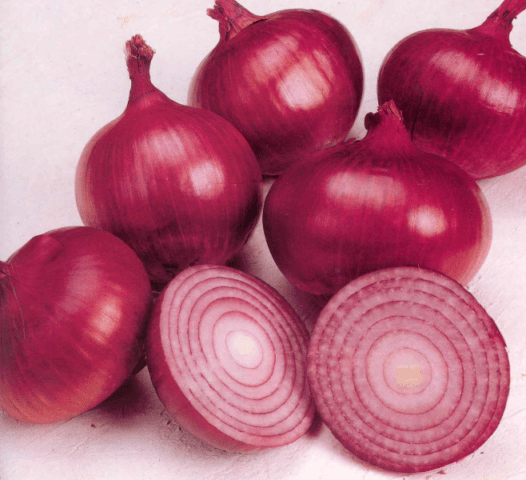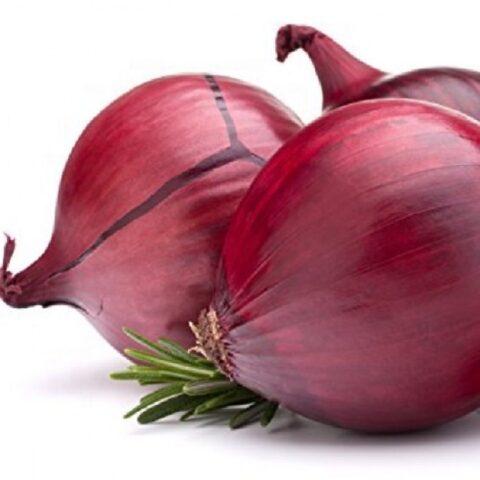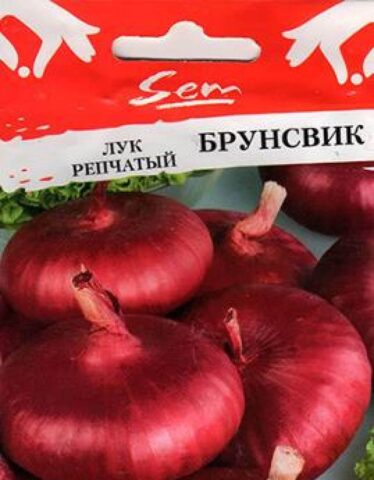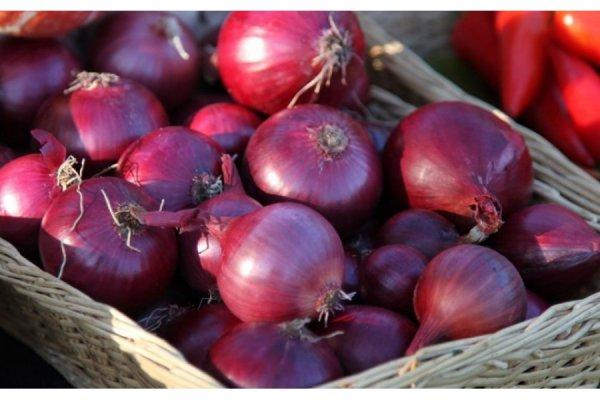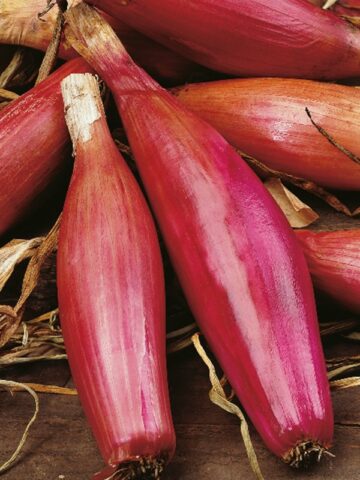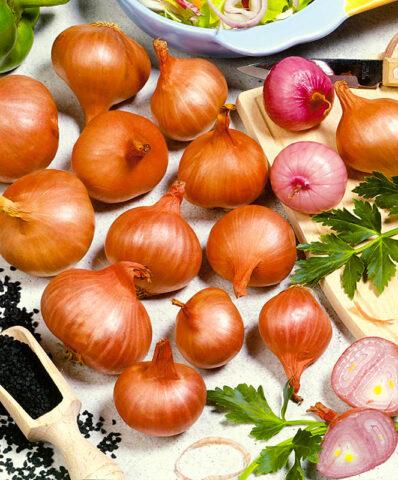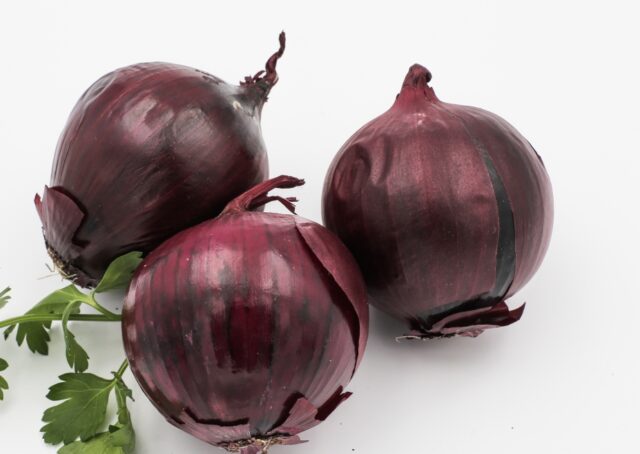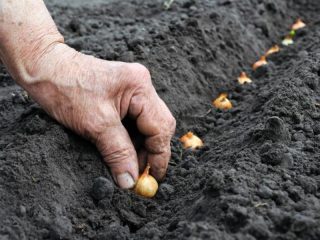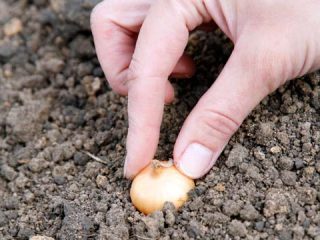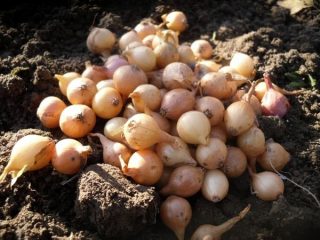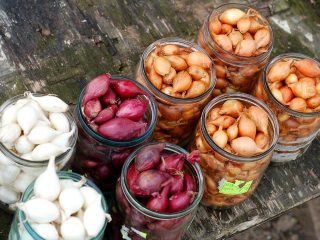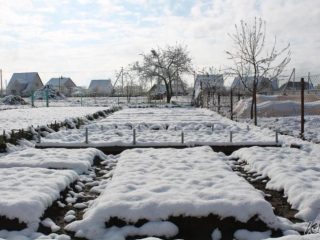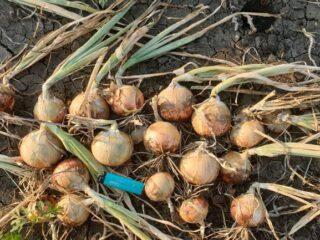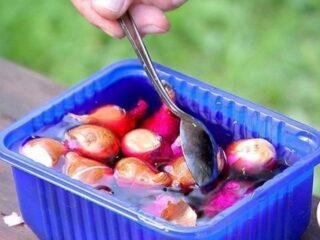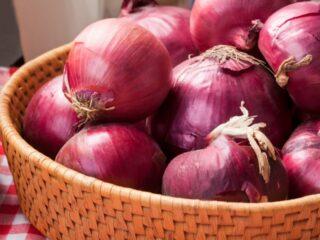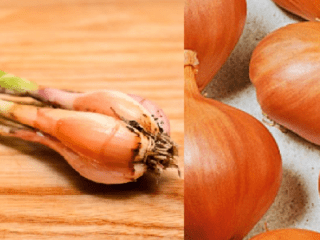Content
The varieties of red onions are quite diverse; in Russia there are several dozen of them. Despite the fact that the crop comes from warm countries, it can be grown even in the climatic conditions of the Urals and Siberia. When choosing a variety, it is worth considering yield, taste, as well as keeping quality and transportability.
What does a red (blue) onion look like?
Red onions are a common variety of onions. It originated in Central Asia and spread to southern European countries, including Portugal, from where it came to Crimea. Therefore, red onions are often called Crimean or Yalta, although in fact this is only one of many varieties.
Externally, turnips have approximately the same shape and size as regular yellow or white onions. They differ in color and taste:
- The first two dry scales are colored a rich bluish-violet color. That's why many varieties of red onions are called blue.
- The pulp itself is reddish-violet, the color alternates with white, thanks to which the root vegetable looks very beautiful when sliced.
- Red onions have a sweeter and less pungent taste. At the same time, its aroma is no different from onion. Since the taste is milder, many types of red onions are used in salads and fresh cold appetizers, without prior treatment with boiling water.
Varieties of red onions with photos and descriptions
Red sweet onions have several hundred varieties and hybrids. Dozens of varieties are grown in Russia. The most popular representatives are described below.
Crimson Ball
The name is associated with the characteristic shape - the head resembles a ball, the color is lilac. The Crimson ball variety is usually grown in seedlings - the seeds are planted 1-1.5 months before transplanting into the ground. The total ripening period is three months from the moment of mass shoots. The taste of this variety is semi-sharp. Turnips should be used immediately, since they are not intended for long-term storage.
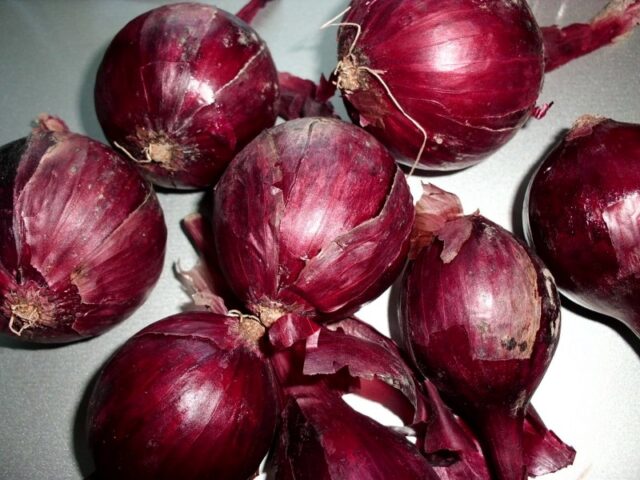
The bulbs of the Crimson Ball variety are dense and tasty
Red Baron
Red Baron is an unusual variety of red onion, which, as can be seen in the photo and description, has a rich dark red color. The taste is excellent, semi-sharp, with a delicate aroma. The turnips are medium in size and can withstand transportation well. If the temperature is maintained, they can be stored for six months (until spring).
The Red Baron variety of red sweet onion can be grown in seedlings and sets. The ripening period is 90-100 days. They are grown for both turnips and greens. Grows well in the climatic conditions of northern regions, including the Urals and Siberia.
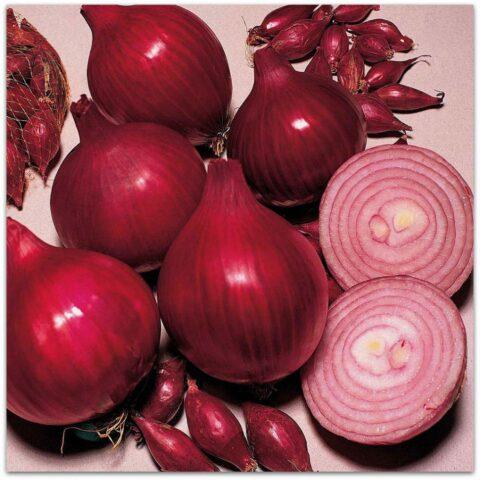
The Red Baron variety can be cultivated in most regions of Russia
Yalta
The Yalta variety of red onion is distinguished by flat, rounded turnips. It was bred in Crimea back in the 19th century, therefore it is also called Crimean (Crimean). The color of dry scales is rich dark purple. The pulp is white, purple on the outside.
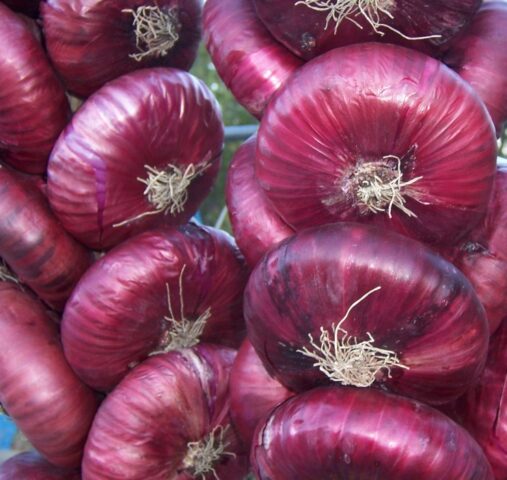
On average, the bulbs weigh 150 g
The thickness of the scales is up to 2 cm, there are no more than seven of them in total. The taste is sweet, barely spicy, pleasant. These onions ripen from late August to early September. The first harvest is harvested at the end of June.
Carmen
The Dutch variety of red sweet onion Carmen appeared in Russia relatively recently, but has already begun to spread among summer residents. The crop is early ripening, ripens in 75-85 days. The bulbs are small, weighing 60-80 g, sometimes up to 120 g.
The pulp density is medium, the shape is round and flat. The taste is excellent, sweetish, moderately spicy, and very juicy in feel. The aroma is pleasant, fragrant. Onions are suitable for salads and other cold appetizers. It can be stored for a long time. If the conditions are met, it remains valid for up to six months.
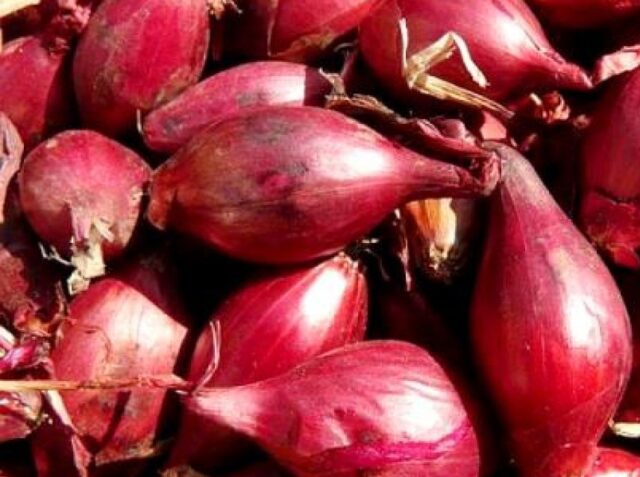
Carmen has good keeping quality, so it can be kept until spring
Although the ripening period is 75-85 days. Therefore, it must be counted from the moment of sowing, so as not to overexpose the root crops in the soil.
Greatful Red F1
Greatful Red F1 is a Dutch hybrid with good commercial qualities. The culture is resistant to fungal infections such as fusarium and root rot. In terms of ripening time, it is classified as mid-season - it ripens in 120 days. The root crop is burgundy, the surface is shiny, the shape is round. The pulp is dense, white, with a slightly pungent, sweetish taste. Productivity is high and stable: subject to compliance with agricultural technology from 10 m2 you can collect from 25 to 35 kg of turnips.
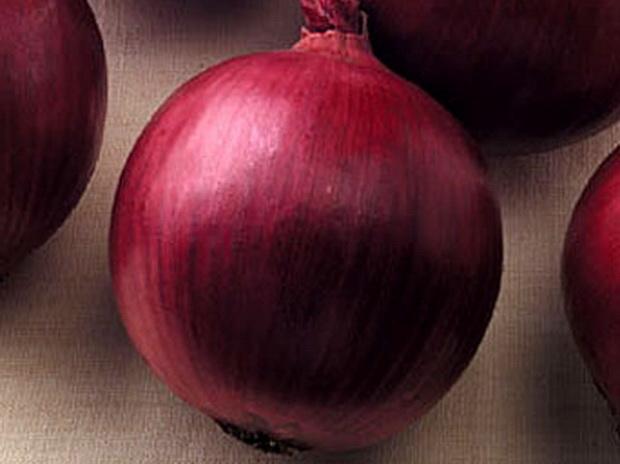
After harvesting, the Greatful Red variety needs ripening
Campillo F1
Campillo F1 (Campillo) is another productive red onion hybrid. The color is scarlet, closer to crimson, while the turnips are round, quite large, weighing on average 120-150 g. The crop is mid-season, the harvest is harvested closer to September. The scales are dense, white with a pinkish tint, and thick.
Campillo F1 is resistant to fusarium and various types of rot. However, it needs to be dried in the beds after harvesting. Then it is taken to a cool room for ripening. It is this procedure that allows turnips to be preserved for several months.
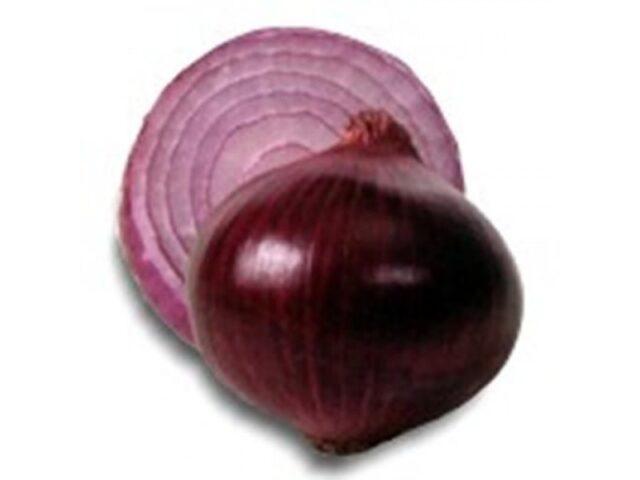
Campillo bulbs are large, weighing up to 150 g
Black Prince
Black Prince is a Russian variety of red onion. The turnips are a rich burgundy color, round in shape, weighing about 80-100 g. The scales are dark purple, with a noticeable crimson tint. The pulp is quite juicy, white, the taste is semi-sharp, sweetish.
The variety has many advantages:
- adapted for cultivation in northern regions;
- good keeping quality and transportability;
- high yield - 40-50 kg per 10 m2;
- resistance to temperature changes.
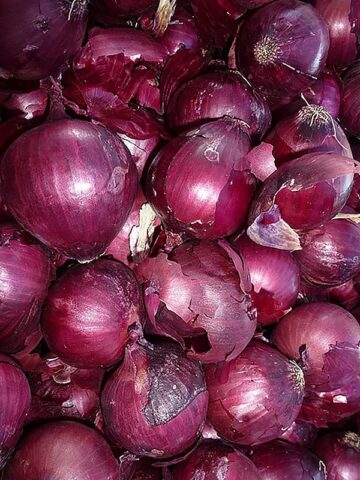
The Black Prince variety ripens in 100-110 days, therefore it is a mid-season variety.
Retro
Retro is an early-ripening salad variety of red onion, produces medium-sized turnips, weighing 80-100 g. Dry scales are dark red, the flesh is white, very tender. The taste is excellent, sweetish and without the slightest bitterness. These bulbs are suitable for cold appetizers. The shape of the root crops is round-flat, sometimes transversely elliptical.
If you sow early, the harvest can be harvested in mid-summer, and if in the usual time (in May), then by mid-August.If you follow agricultural technology, the harvest will be stable and high - 15-20 kg per 1 m2.
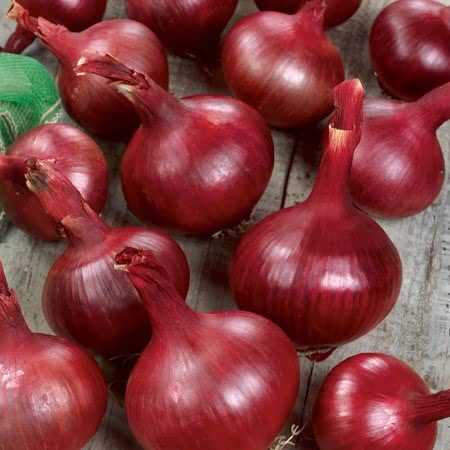
The Retro variety has exceptionally good taste
Brunswick red
Braunschwean red is one of the most beautiful varieties. Produces interesting purple turnips. They ripen, depending on climatic conditions, within 70-110 days from the moment of mass shoots. The root vegetables are round-flat in shape, weighing on average 100 g. The pulp is white with purple rims, the taste is mildly pungent, juicy, pleasant. Gives a good harvest - 25-30 kg per 10 square meters. It has good resistance to many fungal diseases.
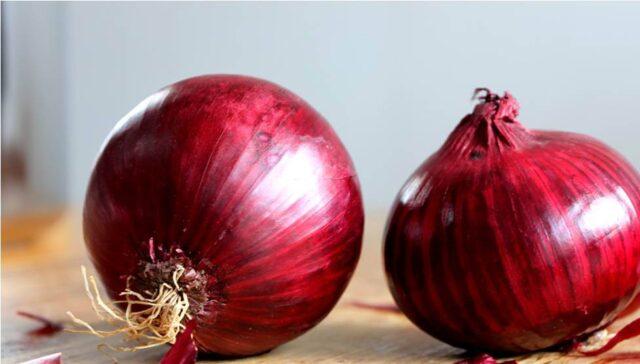
The Brunswick red variety requires ripening
Yucont
Yukont is an early-ripening species; after planting, the sets ripen within 65-75 days. If you plant the seeds, they reach ripeness in 90 days. The shape of the bulbs is flat-round, the heads weigh about 100 g. The taste is quite sharp, sweetish, which adds piquancy to it. Dry scales are bright purple, with a crimson color. Productivity reaches 20-30 kg per 10 m2, it depends on agricultural cultivation technology and weather conditions in the region.
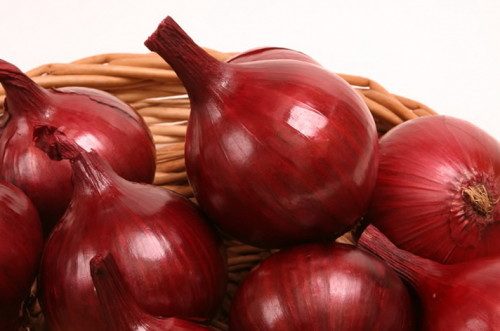
The Yukon variety has a shelf life - it can be stored for up to eight months.
Best Red Onion Varieties by Region
When choosing a variety, it is important to take into account the climatic characteristics of the region, since the weather affects taste, ripening time, keeping quality and other indicators. Therefore, it is better to grow those varieties that are specially adapted to the climate of a particular area. The most popular varieties for regions are described below.
Varieties of red onions for the Moscow region and the middle zone
In the conditions of the middle zone, including the Moscow region, the following varieties can be grown:
- Veselka is a red onion that ripens in 90-115 days.The turnips are round, slightly flattened, weight 75-80 g. The scales are violet-red, the taste is semi-sharp. Good shelf life and transportability, can be stored for up to six months. The variety is suitable for industrial cultivation. Productivity up to 400 c/ha.
- Red Bombay is a medium-ripening onion variety (up to 130-140 days). The turnips are large and dense, weighing up to 150 g, dark red in color, round in shape. The taste is semi-sharp.
- Brunswick Brunswick is a popular medium-ripening variety. The harvest can be harvested 120 days after mass germination. The heads of this variety of red onion are flat and round in shape. The pulp is juicy, pink in color, and the outside is bright purple. The mass of the turnip is about 70 g. The taste is semi-sharp, sweetish - the bulbs are well suited for cold appetizers.
- Mavka is a medium-ripening variety of red onion, harvested in 100-115 days. The yield is high, the weight of the turnip is up to 100 g. The scales are dense, violet-red in color. The taste is sweetish, pleasant, moderately spicy.
Red onion varieties for Siberia
In Siberian conditions, it is necessary to choose crops with early and medium ripening periods. The most suitable varieties:
- Romy is a variety of large red onion, with an average weight of 80-110 g. It is resistant to bolting, has good keeping quality and transportability. At the same time, the crop ripens together, so it can be harvested at one time.
- Florentine torpedo - the name is associated with the characteristic elongated shape of the bow. The root vegetables reach 12 cm in length and 2 times less in width. The pulp is quite dense, tight, and has a pinkish-crimson tint. The husk is crimson and purple, which gives the turnips an attractive presentation.The taste is sweet, a pleasant, moderate pungency is noticeable. Great for salads.
Varieties of red onions for the Urals
The following varieties of red onions are well suited for growing in the climatic conditions of the Urals:
- Ural red is a biennial crop, one of the types of shallots. The skin is dark red, the flesh is reddish with a purple tint. It withstands temperature changes well and is grown not only for turnips, but also for greens. The taste is moderately spicy, sweetish, pleasant. Suitable for salads and any other dishes.
- Black Prince is a Russian type of red onion, bred specifically for the climate of the Urals, as well as Siberia. The crop is mid-season, ripens in 3.5 months. The bulbs are round, the outer scales are a pleasant purple color. The pulp is dense and juicy, soft, with a pleasant sweetish taste. The root crops are short-lived and, if the conditions are met, can be stored until April inclusive.
Conclusion
Red onion varieties have similar appearance and taste. Dry scales are violet, scarlet, rarely purple. The taste is predominantly sweet and moderately spicy, without bitterness or causticity. Therefore, such root vegetables are suitable for all kinds of cold appetizers and salads.
